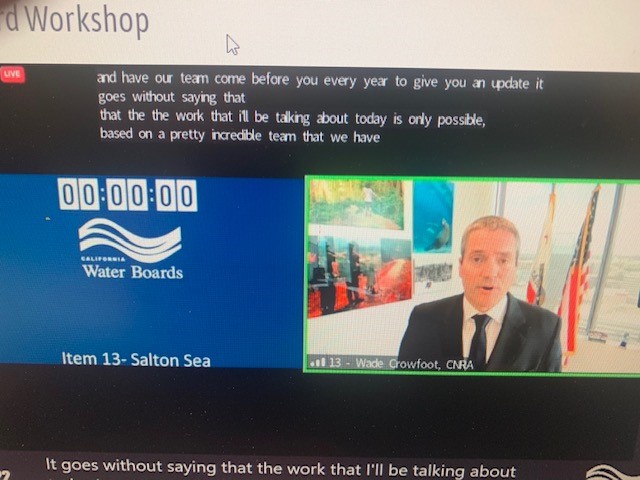
As part of the 2017 Stipulated Order adopted by the State Water Resources Control Board (Water Board), the California Natural Resources Agency (CNRA) must go before the Water Board annually to report on the progress of restoration work at the Salton Sea. CNRA is the agency charged with leading the state’s phased approach to restoration, known as the Salton Sea Management Program (SSMP). On April 20, the CNRA provided its latest report to the Water Board as outlined in the 2022 SSMP Annual Report. During a five-hour hearing, the Water Board voiced its support for the progress at the sea. However, attention turned to next year’s annual report, which officials said will be even more critical. By then, major environmental work will be completed, allowing for a clearer picture of how the SSMP’s Phase 1: 10-Plan will complete coverage of nearly 30,000 acres of exposed playa by 2028 (as required in the Stipulated Order) and how much water will be required to meet that objective.
The hearing began with an opening statement by CNRA Secretary Wade Crowfoot, who outlined SSMP’s progress over the past year, with projects led by a state team that includes CNRA, the California Department of Water Resources and the California Department of Fish and Wildlife. In all, some 6,000 acres of projects are in development and expected to be completed by 2023. This includes the Species Conservation Habitat Project, a 4,100-acre facility consisting of a series of fishponds to serve the needs of fish-eating birds while protecting human health through the coverage of playa. Additionally, the state is developing surface roughening and vegetation enhancement projects and teaming with partnering agencies for projects based around communities, like Desert Shores. As the state looks beyond 2023, it has another 8,000 acres of projects meant to move forward by 2024.
Efforts are also focused on preparing long-range restoration plans that look beyond 2028. CNRA Assistant Secretary Arturo Delgado, in charge of Salton Sea Policy, and his team shared how two separate long-range planning processes are moving forward that will form a consolidated plan to be presented to the Water Board in 2023. One of the processes involves an independent panel led by a team from the University of California, Santa Cruz that is evaluating the feasibility of water importation to the Salton Sea. Separately, the SSMP Long-Range Planning Committee is studying projects that do not involve water importation, instead relying on existing inflows to the sea.
While the Water Board voiced its support for the SSMP’s developments, questions remain that are expected to be addressed in next year’s annual report related to what projects will be developed to complete the Phase 1: 10-Year-Plan between 2024 and 2028, and what water resources will be needed to complete those projects. Delgado reported that over the course of the next few months, the SSMP will complete the environmental assessment and federal NEPA process that will better define future projects and answer the water questions. With that in mind, staff for the Water Board said next year’s hearing will require more time and be more intensive to ensure the Water Board and the public get the answers to the questions that only the environmental assessment can provide.
During the hearing, CNRA acknowledged the efforts of its SSMP partners in advancing restoration projects and also the work of agencies with separate but complementary efforts moving forward. That recognition included the work of the Quantification Settlement Agreement Joint Powers Authority (QSA JPA), which is made up of the Imperial Irrigation District (IID), the San Diego County Water Authority, the Coachella Valley Water District, and the state. The three water agencies have a responsibility to fund environmental mitigation related to the QSA with a funding cap established through legislation at $133 million in 2003 dollars or $287 million in nominal dollars. Most of that funding is geared toward projects at the Salton Sea.
The QSA JPA, with implementation led by the IID, has developed more than 2,000 acres of air quality projects at the sea, including surface roughening and vegetation enhancement projects. Thousands of acres of additional projects are in various planning stages. Additionally, the QSA JPA is moving forward with a pilot project to determine whether groundwater could become a resource for wetland development or to cover exposed playa. Studies by researchers within the University of California system indicate that there could be as much as 30 percent seepage from the sea, which suggests groundwater could be a viable resource.
Stay tuned to this site for further updates on the efforts of the state’s SSMP, the QSA JPA and others working to address the future of the sea.